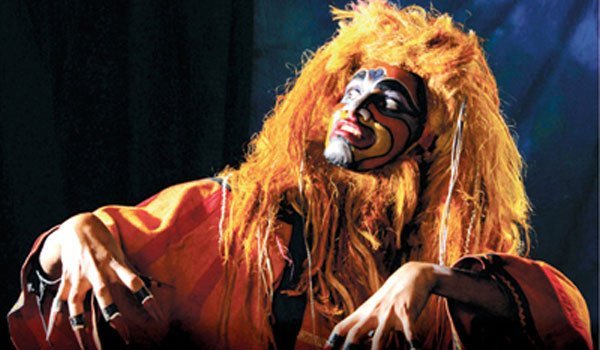We, the Sinhala people call our national flag the "Lion flag". We call it so as we believe the Sinhala race to have originated from Vijaya, Sinhaseevali's son; a twin child of hers. Mahavamsa chronicles Sinhaseevali as a twin child born to Queen Suppa Devi from a "Lion" that lived in the land of "Laala". The "Sinhalé" race thus has an origin from a "Lion". There once were assumptions that "Laala" was present day 'Sihor' in the State of Gujarat. Yet again, there are strong indications that "Laala" is present day "Singapuram" in Andrapradesh. An important reason for such assumption is the authority and spread of ancient Kalinga and Maghadha kindoms in West Bengal, Odissa and down South to Andra and Telugu land. Thus arrival of Vijaya in Thambapanni with a 'Leonic' ancestry that leads to the Sinhala race, originates from Singapuram. He was banished from that land for intolerable rowdy behaviour.
IF there was any necessity to chronicle the origin of the Sinhala race from a human beginning different to the "Leonic" ancestry in Mahavamsa and Deepavamsa, there was that "Jathaka" story in the 27th Ajantha cave in Aurangabad titled "Valaahassa". That story is about "Simhala" the son of a very wealthy merchant "Simha" who arrived with an entourage of 500 men in the island of "Rathnadeepa" in search of "gems". He too takes a "Yakka" princess as wife and he too deserts her later. Yet that story does not have the glory and is not fascinating as the story about the "Lion" told in the Mahavamsa and Deepavamsa. Therefore the story of the "Lion" became fascinating and convincing to not only the chronicler of Mahavamsa, but to those who believed in Sinhala supremacy.
It is heroism, authority and majesty woven around the "Lion" that provides the Sinhala race to wear the halo of pride as " Sinha-lé ". Before the people in this isle of "Héla" created their own pride over its mythical "Leonic" ancestry, folklore, mythology and beliefs in gods and goddesses in the land of the ancient Maha Bharatha had created a divine and a mystic image for the "lion". That was an era the lion had a roaming presence across the Indian subcontinent.
The story of the Lion
That lion is not the African lion that we see captured in photo frames and on our bottle of beer. That lion is identified as the "Asian" lion. There are very noticeable differences between this Asian lion and the more popular African lion. One, the mane of the Asian lion is not as impressive and large as that of the African lion. Two, the tail end of the Asian lion is thicker than that of the African lion.
The Asian lion is a descendant of the African lion that first started moving out from South-East Africa through the Arabian peninsula to Turkey and Southern parts of Europe. Then it gradually spread to Central Asia and to parts of Persia, Balochistan and North India. In 15th Century India, the Asian lion as it was then identified had spread across India from the "Gir" forests in Gujarat to Maharashtra and Bihar and South towards Bengal. Today it is a seriously endangered species, being conserved in "Gir" forests specially restricted for their regeneration.
Mythology and beliefs in greater India
One sign in our zodiac of 12 signs is the "lion" named as "sign of Leo". These zodiac signs according to recorded history were in astrology founded by the ancient Mesopotamian and Sumerian culture. Later the Greeks developed it further. But B.G Siddharth in his book "Celestial Key to the Vedas" published in 1999 says the ancient Indus valley civilisation also had 12 similar zodiac signs much before the Greeks. He cites "Maha Bharatha" and "Rig Veda" as proof. Then too the sign of "Leo" was present as "Simha". In "Samskrit" language of the past, "Simha" was "lion". It goes to prove the "lion" was a powerful animal embedded in the psyche of the ancient Indus valley civilisation.
The ancient Indus valley civilisation had its impact across the large subcontinent far into the North and to its South. Thus goddess Dhurga in Maha Bharatha rides a lion. The twin snow lions in the Tibetan flag is the mythological lion often met in Tibetan folklore. Their snow lion is their symbol of heroism, happiness and their right to the earth they control. It's spiritual strength they gain from the mythological snow lion.
This Asian Lion walks into South Indian culture with equal vigour and reverence. The "Hoy-sala" kingdom that covered present day Karnataka State, patches of Tamil Nadu and Andra had a sculpted lion in most Hindu temples. Under Hoy-sala dominance, Kannada culture developed a rich heritage of sculpture, spiritual art, architecture and accumulated a growing folklore tradition based on heroism and religious beliefs. One such folktale describes a youth named "Sala" swiping a Lion in front of the temple of Goddess Vasanthika to save his Jaina guru Sudgatta. In old Kannada language "swiping" is "Hoy" and that is said to be how the "Hoy-sala" dynasty emerged. The "lion" thus have a very strong hold on the Dravidian culture as well and "Simha" in Samskrit language is adopted as "Singham" in the South Indian society. Most personal names in Dravidian society like Jeyasingham, Veerasingham, Periyasingham, Kanagasingham, Rathnasingham with the suffix "singham" according to some Sociologists is to either denote a kinship with the "Lion" or to prove devotion from ancient past.
All such folklore based on mythology in ancient past is around the male and not the female lion. These folklore highlighting the lion with the mane covers a huge land area of the planet earth from the Nile valley including ancient Egypt, Greece, Persia and Ukraine extending to India, China, Malaysia and Thailand too. We are also a small island that goes under that influence.
Our "Lion"
Yet, our "lion" unlike the Tibetan lion or the "fo-lion" in Chinese Buddhist mythology has no spiritual definition. In ancient Egypt the "lion" was the guardian of the Pharaohs. We did not have such a rich cultural binding given to the "lion". We give importance to the "lion" as the maternal grandfather of Vijaya, the source of the Sinhala race. That lion is only a weird creature that lived in Singapuram and took Suppa Devi as his concubine.
The king of the forest, lions live in small groups called "prides". They number about 3 to 4 male lions living with about 7 to 8 females and their cubs. The male lion is no hunter. Not even for food. It is the female lions that go after prey and hunt for food. The male lion only hurries to devour the hunted prey. Male lions spend most of their time resting leisurely in the shades. The lion is thus a "king" in the forest as the only beast that has his "lion's share" in food with no effort made and could mate the female of its choice from a harem around it, when its mating time.
Our "lion" and "our beer"
Around 15 years ago, or maybe even a few years before, the popular local brand "Lion" beer used few such lazy male lions for market promotion in a very creative advertisement in mainstream media. A few male lions after a hefty meal are shown ambling over to a river for water. They are then shown under a huge shade yawning full and lazy. The line that punches the message is a question, "We are the Lion dynasty. And You?" The message was clear. 'If you want to enjoy a happy lion's life with friends in the evening, it's "Lion" beer.
That in fact is the total understanding of the "lion". If parables and mythology are left out, the "lion" is nothing more.
Although we have given a sword to the lion in our flag, it is no beast that knows about hunting prey. That therefore can only define authority of a lion to live a lazy life. We have not been able to add anything rich and worthy to cultural and traditional borrowings we have accumulated in the past from ancient India. So is it with the "lion" and its kingly image.
Kusal Perera






